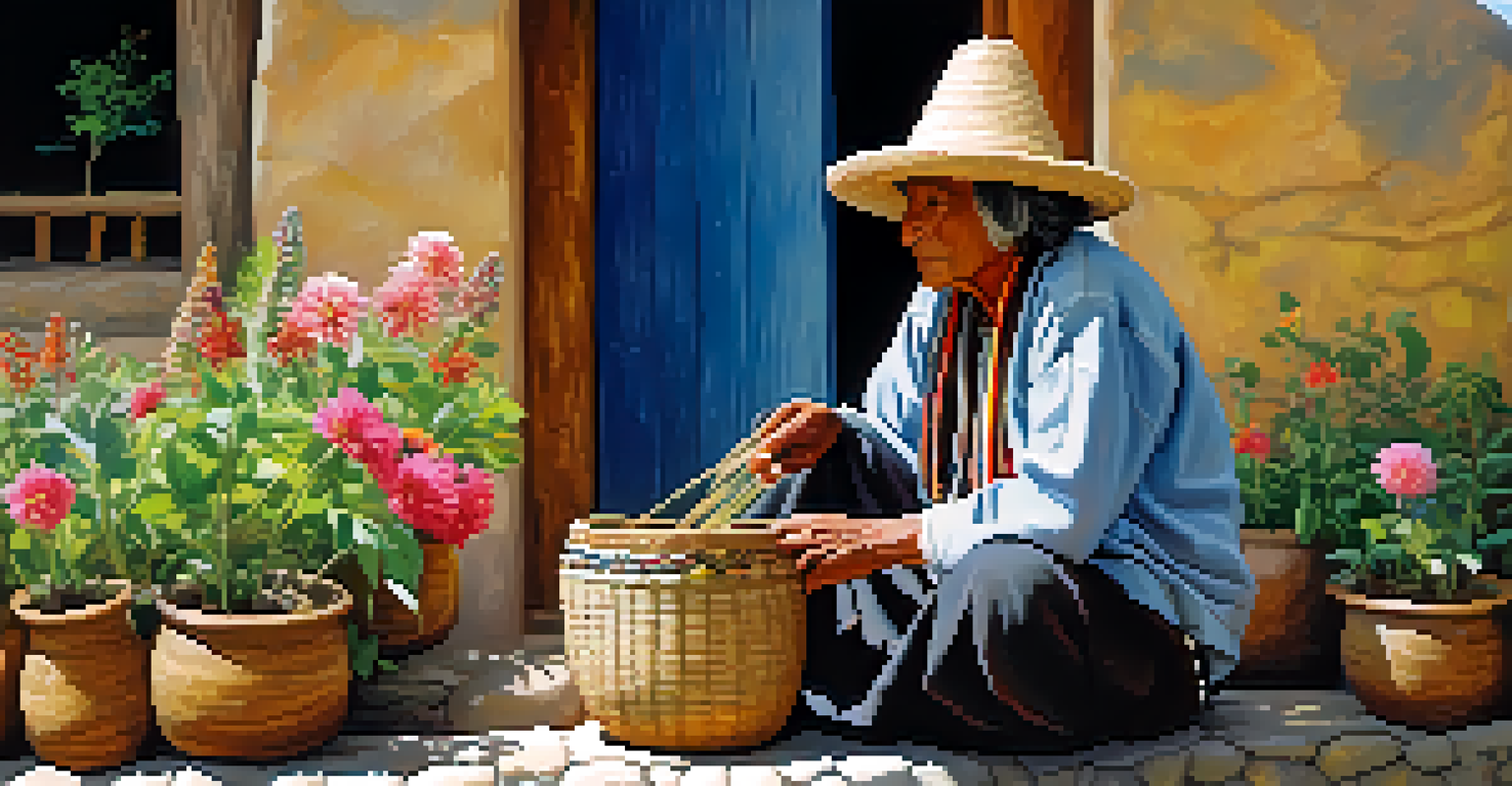Quechua: The Most Widely Spoken Indigenous Language in Peru

An Overview of Quechua's Rich History and Significance
Quechua, a language with deep roots in the Andes, has a rich history that dates back to the Inca Empire. It's fascinating to think about how this language has survived through centuries of change and upheaval, becoming a crucial part of Peru's cultural identity. Today, Quechua is not only spoken in Peru but also in parts of Bolivia, Ecuador, and Colombia, making it a vital part of the Andean heritage.
Languages are not just a means of communication; they are the very fabric of our culture and identity.
The survival of Quechua is a testament to the resilience of Indigenous cultures. Despite facing challenges such as colonization and globalization, Quechua speakers have worked hard to preserve their language and traditions. This dedication has fostered a sense of pride among speakers and helps keep the Quechua culture alive.
In modern Peru, Quechua is recognized as an official language alongside Spanish. This acknowledgment is an important step toward preserving Indigenous languages and cultures, emphasizing their significance in the national identity. It opens doors for further education and resources for Quechua speakers, ensuring the language thrives for future generations.
Quechua Dialects: A Language Rich in Variations
One of the intriguing aspects of Quechua is its dialectical diversity. There are several dialects spoken across different regions, with variations in pronunciation and vocabulary. For instance, the Quechua spoken in the Cusco region can differ significantly from that spoken in the highlands of Bolivia, showcasing the language’s adaptability to its environment.

These dialects not only reflect geographical differences but also cultural nuances. Each region has its own stories, traditions, and expressions that are woven into the fabric of their version of Quechua. This rich tapestry of dialects enriches the language and provides a deeper understanding of the local cultures.
Quechua's Rich Cultural Heritage
Quechua is deeply intertwined with the history, traditions, and identity of Indigenous communities, serving as a vital link between generations.
However, this diversity also presents challenges for language preservation, as some dialects are at risk of fading away. Efforts are being made by communities and organizations to document and promote these dialects, ensuring that the unique voices of each region continue to be heard and celebrated.
Quechua in Education: Challenges and Progress
Incorporating Quechua into the education system has been a significant step toward its preservation. Many schools in Peru now offer Quechua classes, allowing students to learn not only the language but also the culture that comes with it. This educational approach helps foster a sense of identity among young Quechua speakers and encourages them to embrace their heritage.
The survival of a language is a testament to the resilience of its people and their culture.
However, challenges remain. Many teachers may not be fully fluent in Quechua, which can impact the quality of education. Additionally, there is often a lack of resources and materials for teaching the language effectively, which can hinder progress in schools.
Despite these hurdles, community initiatives and government support are paving the way for improvements. Workshops and training programs for teachers are being established, helping to equip them with the skills needed to teach Quechua effectively. This collaborative effort is essential for ensuring that Quechua continues to be a vibrant part of education in Peru.
Quechua in Media: A Modern-Day Revival
The rise of digital media has opened new avenues for promoting Quechua. Social media platforms, podcasts, and YouTube channels are now featuring content in Quechua, making the language accessible to a broader audience. This modern approach helps to engage younger generations, who might otherwise feel disconnected from their linguistic roots.
Several television and radio programs also broadcast in Quechua, allowing speakers to connect with their culture in contemporary contexts. This not only promotes the language but also showcases the rich storytelling traditions inherent in Quechua culture. It's exciting to see how these platforms are helping revive interest in the language.
Challenges in Language Preservation
Despite its recognition as an official language, Quechua faces challenges such as limited resources in education and the influence of globalization.
Moreover, the use of Quechua in popular music has also contributed to its resurgence. Artists are incorporating Quechua lyrics into their songs, blending traditional sounds with modern genres. This fusion not only entertains but also raises awareness about the language, encouraging listeners to appreciate its beauty.
Cultural Significance: Quechua as a Living Heritage
Quechua is more than just a means of communication; it is a vessel of culture, history, and identity. The language is deeply intertwined with traditions, rituals, and community practices, serving as a bridge between generations. For many speakers, using Quechua is a way to connect with their ancestors and maintain a sense of belonging.
Many Quechua words and phrases encapsulate concepts that are unique to the Andes, emphasizing a relationship with nature and community that might be lost in translation. For example, specific terms describe local flora and fauna, illustrating a deep understanding of the surrounding environment. This connection to nature is integral to the Quechua worldview and is often reflected in their art and storytelling.
As efforts to celebrate and revitalize Quechua grow, many communities are embracing cultural events that highlight the language. Festivals, storytelling sessions, and art exhibitions showcase Quechua traditions, allowing speakers and non-speakers alike to appreciate its richness. This cultural renaissance reinforces the idea that Quechua is a living heritage, deserving of respect and preservation.
The Global Impact of Quechua Language and Culture
Quechua’s influence extends beyond Peru and the Andes, impacting global discussions about Indigenous rights and languages. As more people learn about Quechua, awareness grows about the importance of preserving Indigenous cultures worldwide. This has led to increased support for language revitalization efforts and recognition of the value of linguistic diversity.
In an age where globalization often homogenizes cultures, Quechua stands as a symbol of resilience and cultural pride. The language has become a focal point for activism, with many advocating for the rights of Indigenous peoples to maintain their languages and traditions. This movement highlights the importance of cultural preservation in our increasingly interconnected world.
Modern Revival Through Media
Digital platforms and popular music are revitalizing interest in Quechua, engaging younger generations and promoting cultural pride.
Moreover, the global community is learning from the Quechua experience. Initiatives aimed at preserving Indigenous languages are being implemented in various countries, recognizing that every language carries unique knowledge and perspectives. By celebrating Quechua, we can inspire similar movements and elevate the voices of Indigenous communities globally.
The Future of Quechua: Hope and Challenges Ahead
The future of Quechua holds both promise and challenges. On one hand, the growing interest in Indigenous cultures and languages is encouraging. With more resources being allocated for education and cultural initiatives, there is hope that Quechua will continue to thrive among younger generations.
Conversely, the influence of globalization and modernization poses a threat to the survival of the language. As urbanization increases, younger speakers may gravitate towards dominant languages like Spanish or English, potentially sidelining Quechua. This shift could lead to a decline in fluent speakers if not addressed.

To secure a vibrant future for Quechua, it’s crucial to foster a sense of pride and ownership among speakers. Community-led initiatives, educational reforms, and cultural celebrations can all contribute to revitalizing interest in the language. By embracing both tradition and modernity, the Quechua language can continue to flourish as an essential part of Peru’s cultural tapestry.